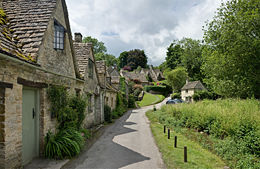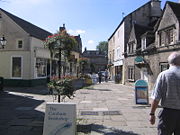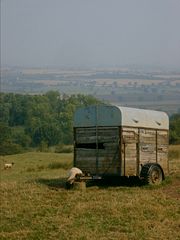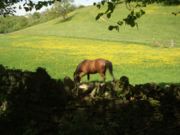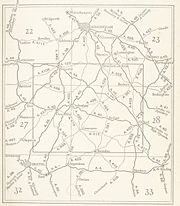Cotswolds
2008/9 Schools Wikipedia Selection. Related subjects: Geography of Great Britain
| Cotswolds | |
|---|---|
| Area of Outstanding Natural Beauty | |
|
The village of Bibury features Cotswold stone cottages
|
|
| Country | England |
| Counties | Gloucestershire, Oxfordshire, Somerset, Warwickshire, Wiltshire, Worcestershire. |
| Highest point | |
| - location | Cleeve Hill |
| - elevation | 330 m (1,083 ft) |
| Plant | Hawkweed, Pasque flower, Woolly Thistle, Yellow Archangel. |
| Animal | Badger, Goldfinch, Grey Wagtail, Treecreeper |
The Cotswolds is a range of hills in west-central England, sometimes called the "Heart of England", an area 25 miles (40 km) across and 90 miles (145 km) long. The area has been designated as the Cotswold Area of Outstanding Natural Beauty. The highest point in the Cotswolds range is Cleeve Hill at 1,083 ft (330 m), 2.5 miles (4 km) to the north of Cheltenham.
Location
The Cotswolds lie mainly within the ceremonial counties of Gloucestershire and Oxfordshire, but extend into parts of Wiltshire, Somerset, Worcestershire and Warwickshire.
Description
The spine of the Cotswolds runs south west to north east through six counties, particularly Gloucestershire, west Oxfordshire, and south western Warwickshire. The northern and western edges of the Cotswolds are marked by steep escarpments down to the Severn valley and the Warwickshire Avon. This escarpment or scarp feature, sometimes called the Cotswold Edge, is a result of the uplifting (tilting) of the limestone layer, exposing its broken edge. This is a cuesta, in geological terms. The dip slope is to the south east. On the eastern boundary lies the city of Oxford and on the west is Stroud. To the south-east the upper reaches of the Thames Valley and towns such as Lechlade, Tetbury and Fairford are often considered to mark the limit of this region. To the south the Cotswolds, with the characteristic uplift of the Cotswold Edge, reach as far south as Bath and towns such as Chipping Sodbury and Marshfield share elements of Cotswold character.
The area is characterised by attractive small towns and villages built of the underlying Cotswold stone (a yellow oolitic limestone). This limestone is rich in fossils, in particular fossilised sea urchins. In the Middle Ages, the wool trade made the Cotswolds prosperous; hence the Speaker of the British House of Lords sits on the Woolsack showing where the Medieval wealth of the country came from. Some of this money was put into the building of churches so the area has a number of large, handsome Cotswold stone " wool churches". The area remains affluent and has attracted wealthy people who own second homes in the area or have chosen to retire to the Cotswolds.
Typical Cotswold towns are Bourton-on-the-Water, Broadway, Burford, Chipping Norton, Cirencester, Moreton-in-Marsh, Stow-on-the-Wold and Winchcombe. The town of Chipping Campden is notable for being the home of the Arts and Crafts movement, founded by William Morris at the end of the 19th and beginning of the 20th centuries. William Morris lived occasionally in Broadway Tower a folly now part of a country park. Chipping Campden is also known for the annual Cotswold Games, a celebration of sports and games dating back to the early 17th century.
Area of Outstanding Natural Beauty
The Cotswolds were designated an Area of Outstanding Natural Beauty (AONB) in 1966, with an expansion on 21 December 1990 to 1,990 square kilometres (768 sq mi). In 1991 all AONBs were measured again using modern methods. The official area of the Cotswolds AONB increased to 2,038 square kilometres (787 sq mi). In 2000 the government confirmed that AONBs had the same landscape quality and status as National Parks.
The largest of 40 AONBs in England and Wales, the Cotswolds AONB stretches from the border regions of South Warwickshire and Worcestershire, through West Oxfordshire and Gloucestershire and takes in parts of West Wiltshire and Bath and North East Somerset in the South.
The Cotswold Way is a long-distance footpath, approximately 103 miles (166 km) long, running the length of the AONB, mainly on the edge of the Cotswold escarpment with views over the Severn Valley and the Vale of Evesham.
The Cotswold Voluntary Wardens Service was established in 1968 to help conserve and enhance the area. There are now over 300 Wardens. In 2005 they gave over 36,000 hours of their time.
Principal Settlements
- Shipston-on-Stour
- Chipping Campden
- Broadway
- Moreton-in-Marsh
- Winchcombe
- Chipping Norton
- Stow-on-the-Wold
- Burford
- Cirencester
- Tetbury
- Wotton-under-Edge
Noteworthy historical structures
- Beverston Castle
- Calcot Manor
- Chavenage House
- Chedworth Roman Villa
- Cirencester Abbey
- Malmesbury Abbey
- Owlpen Manor
- Sudeley Castle
- Tetbury Market House
Transport
The Cotswolds is ringed by the M5, M40 and M4 motorways, giving easy access to the area. The main non-motorway roads through the area are the A46: Bath — Stroud — Cheltenham; the A419: Swindon — Cirencester — Stroud; the A429: Cirencester — Stow-on-the-Wold — Moreton-in-Marsh; and the A40: Oxford — Burford — Cheltenham. These all roughly follow the routes of ancient roads, some laid down by the Romans, such as Ermin Street and the Fosse Way.
The area is bounded by two major rail routes: in the south by the main Bristol-Bath-London High Speed line and in the west by the Bristol-Birmingham main line. In addition, the Cotswold Line runs through the Cotswolds from Oxford to Worcester, and the Golden Valley Line runs from Swindon to Gloucester, carrying high speed and local services.
Main line, high speed rail services to the big cities are reached via stations such as Bath, Swindon, Oxford, Cheltenham and Worcester. High speed services to London are also available from Kemble station near Cirencester, Kingham station near Stow-on-the-Wold and Moreton-in-Marsh station.
Cheltenham is a hub for National Express coach services. There are local bus services across the area, but some are infrequent. The best sources of information are the Gloucestershire County Council website, or local tourist information centres.
In popular culture
Writer and comedian Karl Pilkington writes of a holiday to the Cotswolds in his book Happyslapped by a jellyfish. The story was read in 2007 on the Ricky Gervais Show.
British playwright and actress Charlotte Jones set her award winning play Humble Boy the Cotswolds. Humble Boy received the Smith Blackburn Award, 2001, as well as the Critics' Circle Award for Best New Play and the People's Choice New Play Award in 2002.
